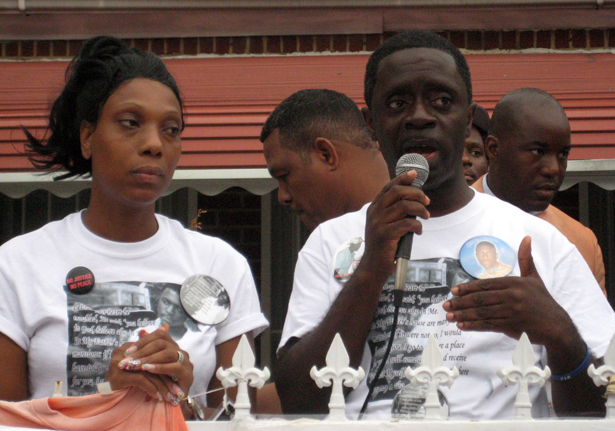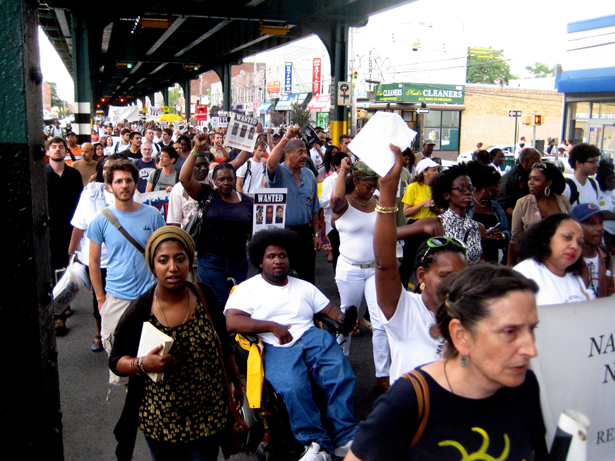
Ramarley Graham’s parents, Constance Malcolm (left) and Franclot Graham, speak to supporters. (Lucy McKeon)
Around 4:30 in the afternoon on Thursday, July 19, a crowd began to gather on East 229 street in the Wakefield section of the Bronx. Reggae and R&B wafted down the block like a smoke signal from the house where 18-year-old Ramarley Graham was shot and killed by New York City police officer Richard Haste on Thursday, February 2. Ramarley’s 6-year-old brother and grandmother were both in the house that day when, unarmed and followed into his home by police without a warrant, Ramarley was shot in his bathroom.
Members of the community, activists, supporters and family have been meeting outside the house to hold weekly vigils for eighteen Thursdays, each vigil marking one of the eighteen years of Ramarley’s life. This past Thursday was the eighteenth and final vigil, and by 5 pm hundreds of people spilled from the sidewalks into the street. Children ran around the front yard while Ramarley’s parents, Constance Malcolm and Franclot Graham, made final preparations and greeted visitors. Banners lining the gate with pictures of Ramarley asked, “You see my hands, no gun. Why did you shoot me?”
The vigil began with impassioned pleas for justice by friends, activists, and families who knew the pain of Ramarley’s parents all too well. “Let this be the one that stops them,” said Juanita Young, mother of Malcolm Ferguson, who was killed by police in the South Bronx in 2000. All around, supporters from groups like Copwatch, Fathers Alive in the Hood (FAITH), the National Action Network and Picture the Homeless, waved signs and chanted, “I am Ramarley!” A member of the New Black Panther Party reminded the crowd, “Ramarley’s death does not happen in a vacuum.”
The chasm between the promise and reality of the NYPD’s responsibility to “protect and serve” communities of color has long defined the relationship between the two groups. Few administrations embodied this gulf more flagrantly than that of Mayor Rudolph Giuliani, whose mayoralty was punctuated by the murders of Amadou Diallo, Patrick Dorismond, and Anthony Baez, among others, as well as the brutal assault of Abner Louima. Yet under Mayor Michael Bloomberg and his police chief, Raymond Kelly, police conduct has been equally brazen and aggressive. The rhetoric may be kinder and gentler, but the reality has been no less belligerent.
“If you look at the actual effect of policing practices—the sheer scale of them in New York City during Bloomberg-Kelly versus Giuliani—you could make a strong argument that police practices are worse, that they’re more unconstitutional now than under Giuliani,” said Darius Charney, senior staff attorney at the Center for Constitutional Rights.
Charney was referring specifically to the NYPD’s wanton stop-and-frisk practices, which disproportionately affect New Yorkers of colors and have jumped 600 percent since Bloomberg took office a decade ago. (Charney is the lead counsel in a federal class action lawsuit challenging the NYPD’s stop-and-frisk practices). In 2011 alone, the police stopped 685,724 people, though only 12 percent of these stops led to arrests or summonses and just 2 percent to the recovery of contraband, according to the Center for Constitutional Rights. Eighty-four percent of those stopped were black or Latino, and the vast majority were young men.
Popular
"swipe left below to view more authors"Swipe →
As for the high-profile police brutality cases that dominated headlines during the Giuliani era, Charney warned against letting Bloomberg off the hook there as well. “There were many publicized incidents of police brutality under Giuliani,” he said, “but there have been many under Bloomberg as well, some really horrific incidents.”
Ramarley’s own story unfolded in particularly lawless fashion on the afternoon of February 2. After leaving a bodega that the Street Narcotics Enforcement Unit had been staking out, he walked up to his family’s home (some publications reported that he ran into the house, though video surveillance footage showed him walking) and casually opened the door. Several minutes later, police barged into the house, guns drawn, and tracked Ramarley into the bathroom, where they later alleged he was trying to flush a baggie of marijuana down the toilet. Richard Haste, the officer who killed him, claims that he feared Ramarley had a gun and yelled “Show me your hands”—to which Ramarley responded by reaching for his belt. No weapon was found.
Haste, 31, has since been indicted, which is the first indictment of an on-duty New York City police officer for a shooting since March 2007, when three detectives were indicted (and later acquitted) for killing Sean Bell, a 23-year-old father and husband-to-be who had been out celebrating on the eve of his wedding. Like the detectives in the Bell case, Haste has pleaded not guilty. His trial will be held September 13.

Protesters demand justice as they march to the 47th Precinct station in the Bronx. (Lucy McKeon)
At Thursday’s vigil, Ramarley’s parents spoke last, thanking the crowd for coming out. Wearing T-shirts and buttons emblazoned with their son’s face, they stood side by side, clearly exhausted, their eyes seemingly focused on something indefinite. Once or twice, recognizing a friend in the crowd, their faces broke briefly into grateful smiles.
In the wake of their son’s murder, both Malcolm and Graham have become dedicated activists, the newest additions to a long tradition of bereaved New York parents fighting for accountability. “My biggest concern now is when [my 6-year-old son] passes a cop, he’s looking back and he’s pulling away,” Ramarley’s mother told me later. “I’m like, ‘Not all cops are bad.’ And he says, ‘But Mommy they killed Marley.’”
The relationship between the police and the community has changed since she emigrated from Jamaica, Malcolm added. “When I came to this country, when I was 13 years old, we had cops in our community that knew people, interacted with people, got to know the kids,” she said. “We don’t see that anymore. All we see is cops pushing us against the wall. We’re automatically suspects.”
Around 7 pm, the marchers paused at the 47th Precinct station house, the crowd swelling with passersby. Police officers stood outside looking down, some somberly, one with a slight smirk. A woman read aloud from a petition demanding national action to stop police brutality, adding, “Stop using black-on-black crime to justify stop-and-frisk. If you want to stop and frisk something, check your officers!”
The sun was already setting by the time the marchers arrived at their final gathering spot, Crawford Memorial Methodist Church, where Ramarley’s funeral had been held months earlier. Ramarley’s family sat on the dais, alongside the families of other New Yorkers who’d been killed by police violence: Sean Bell, Kenneth Chamberlain and Shantel Davis, a 23-year-old unarmed woman fatally shot by NYPD in East Flatbush July 12. The Reverend Al Sharpton, fresh from the side of Trayvon Martin’s family, opened with an exhortation to keep up the call for police accountability. “This is the end of a phase,” he said, referring to Malcolm and Graham’s organizing, “and the beginning of a new phase. We will stay with this family until we see the justice they deserve.”
For City Councilman Jumaane Williams of Brooklyn, who spoke later in the evening, the message was the importance of the upcoming mayoral election. “Don’t dare tell me that I have to make a choice between safer streets and better police,” Williams said, pointing out that only one of the expected mayoral candidates, New York City Comptroller John Liu, was present at the vigil. (Williams’ words were informed by personal experience. At the West Indian Day Parade in September 2011, he was handcuffed and briefly detained by the police for trying to walk on a sidewalk reserved for elected officials—like him. Afterwards, Williams wrote in the New York Daily News, “If I were not an elected official, I would have been taken to central booking and charged, no questions asked.”)
By 9:30, the vigil was winding down, but for Ramarley’s family, the push for justice is far from over. On August 2, sixth months after Ramarley’s death, Malcolm, Graham, and their supporters are organizing a motorcade rally which will drive from Ramarley’s family’s house to the cemetery where he is buried. “I’m looking to see the same magnitude of people that I saw last night because we’re trying to build a movement,” Malcolm told me the day after the vigil. “We want a movement. You see Sean Bell’s wife, you see Shantel Davis’s family, Kenneth Chamberlain’s son. We want them to see we are united. United through tragedy, but we try to make a difference.” She spoke of the voter registration drive they plan to organize.
Malcolm always told her children to fight for what they believe in. “That’s why I can’t rest. I’m tired, but I know I can go back out there,” she said. “It’s not just about Ramarley. I’m fighting for all these black and Latino men out here, because this is who this problem is affecting. And I’m fighting for my 6-year-old son, knowing that if he gets older and he sees a cop and tries to run, he might get shot in the back—not because he’s doing something wrong, but because he’s scared.”
For details about the August 2 rally, visit www.ramarleyscall.org or Ramarley’s Call on Facebook.


